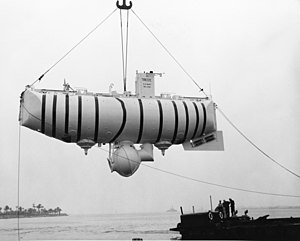
Back Трыест (батыскаф) Byelorussian Batiscaf Trieste Catalan Batyskaf Trieste Czech Trieste German Trieste (submarŝipo) Esperanto Batiscafo Trieste Spanish Trieste (batüskaaf) Estonian Trieste (batiskafoa) Basque بتیسکف تریسته Persian Trieste (batyskafi) Finnish
 Trieste shortly after her purchase by the US Navy in 1958
| |
| History | |
|---|---|
| Name | Trieste |
| Builder | Acciaierie Terni/Cantieri Riuniti dell'Adriatico |
| Launched | 1 August 1953[1] |
| Fate | Sold to the United States Navy, 1958 |
| Name | Trieste |
| Acquired | 1958 |
| Decommissioned | 1966 |
| Reclassified | DSV-0, 1 June 1971 |
| Status | Preserved as an exhibit in the U.S. Navy Museum |
| General characteristics | |
| Type | Bathyscaphe |
| Displacement | 50 long tons (51 Mg) |
| Length | 59 ft 6 in (18.14 m) |
| Beam | 11 ft 6 in (3.51 m) |
| Draft | 18 ft 6 in (5.64 m) |
| Complement | Two |
Trieste is a Swiss-designed, Italian-built deep-diving research bathyscaphe. In 1960, it became the first crewed vessel to reach the bottom of Challenger Deep in the Mariana Trench, the deepest point in Earth's seabed.[2] The mission was the final goal for Project Nekton, a series of dives conducted by the United States Navy in the Pacific Ocean near Guam. The vessel was piloted by Swiss oceanographer Jacques Piccard and US Navy lieutenant Don Walsh. They reached a depth of about 10,916 metres (35,814 ft).
The bathyscaphe was designed by Swiss scientist Auguste Piccard, the father of pilot Jacques Piccard. It was built in Italy and first launched in 1953. The vessel was first owned and operated by the French Navy until it was purchased by the US Navy in 1958. It was taken out of service in 1966. Since the 1980s, it has been on exhibit in the National Museum of the United States Navy in Washington, D.C.
- ^ Piccard 1956, p. 107.
- ^ "First Trip to the Deepest Part of the Ocean The Bathyscaphe Trieste carried two hydronauts to the Challenger Deep in 1960". Geology.com. 2005-2015 Geology.com. Retrieved 27 April 2015.
© MMXXIII Rich X Search. We shall prevail. All rights reserved. Rich X Search